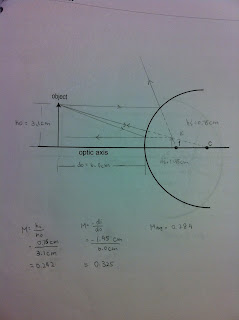Introduction:
The purpose if this experiment it to determine the distance between the grooves on the CD. The groove spacing obtained will be compared to the manufacturer's standard value, 1600nm.
Procedure:
First, we first set up the experiment with a lhelium neon laser perpendicularly to the surface of the disk. As the laser hit the surface of the CD, the laser beam diffract and split into multiple beams of light. Both the CD and the laser should be adjusted until the the zero order maximum would shown on the board. Then record the the perpendicular distance between the board and the disc and the distance between the maximums.

Data and Analysis
tan(θ) = x/L
d=mλ/sin(θ)
λ (nm)
|
X (cm)
|
L(cm)
|
θ(rad)
|
d(nm)
|
% error
| |
Trial #1
|
633
|
17.8 ± 0.1
|
35.5 ± 0.1
|
26.6°
|
1413.7
|
- 11.5
|
Trial #2
|
633
|
13.2 ± 0.1
|
32.1 ± 0.1
|
22.4°
|
1661.1
|
4.4
|
Trial #3
|
633
|
24.8 ± 0.1
|
51.5 ± 0.1
|
25.7°
|
1459.0
|
- 8.8
|
Conclusion
This experiment let us have a better understanding of laser diffraction and how it can be used to measure defects in
CD spacing. However, there are some errors for the data we collected in the experiment. Since we hold the screen between the laser and CD by hand, and we do not hold the screen to be perpendicular to the laser and CD, which makes the measured distance between the CD and screen L and calculated distance x not accurate. With more precise instrumentation would could significantly decrease our percent uncertainty and difference to more accurately the CD's spacing.













